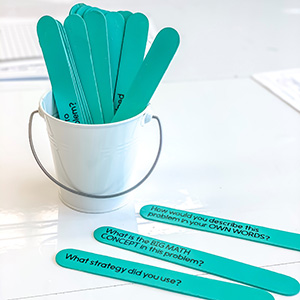Engage All Students With Questioning Strategies
How many times have you heard an administrator, professional development presenter or master teacher say, “100% engagement”? I have lost count. Would you believe me if I said there really is a way to engage all of your students, even the most distracted, most reluctant learner? 100% engagement is possible!
I started implementing questioning strategies my very first year of teaching, and I believe it is the key to student success, classroom management, and of course, engagement. Before you even start implementing this cycle of questioning, it is important to set some ground rules and expectations. I call my classroom a “no blurt zone.” I know allowing those few students to shout out their answers may help the flow of a lesson, but you have to be a stickler — don’t allow it! 100% engagement is impossible with blurters.

The cycle of questioning consists of think time, turn-and-talk and randomizing how you call on students.
-
Think time
Allowing students to think about your question in silence is so important. Long silences can be awkward and sometimes seem like a distant dream. However, if you model what “think time” looks like, it will be the most important few seconds of your class. Set up think time by saying, “I want you to think about this for a minute. Don’t shout anything out; just think about the question and what it means.” You can set a timer, or just feel the room as students think. By doing this, you allow your varied learners to come up with a response to your question on their own without the pressure of rushing to keep up with the typical blurters.
But, what about the kids who don’t come up with anything or don’t want to share? This is where “turn-and-talk” comes into play.

Students work together on an assignment with their calculators. -
Turn-and-talk
Just as straightforward as it sounds, turn-and-talk happens immediately after “think time.” Not only do students collaborate about their ideas, but students who may need some help can talk to a peer to get the ideas flowing. This step also removes the anxiety of being called on in class. No matter which student you call on after this period, everyone should have something to share.
Teacher tip: Set clear expectations for turn-and-talk with your senses. Have students model what turn-and-talk should look like and sound like, even with older kids. Set them up for success by clearly outlining what you expect from your students from beginning to end.
-
No more raising hands — randomize how you call on students
There are so many ways to diversify how you call on your kids: popsicle sticks, randomization apps or simply following a pattern (I go down the row of students). This way, you are not only allowing all students to share, but you are also holding them all accountable. 100% engagement!
I believe that randomizing how you call on students is a key component to achieving a perfect engagement rate.
Even if you’re not going through the whole cycle of questioning, students understand your expectations and can foresee being called on at any time during the lesson. No matter how difficult or easy a question may be, be sure to call on every one of your students. Whether you are asking your students to explain the theory behind the Pythagorean Theorem, or what the product of 2 and 3 is, every single student should be given an equal opportunity to engage in the lesson. In turn, everyone is engaged.
STAAR is a registered trademark of the Texas Education Agency.
Kraus Math is a registered trademark of its owner.
About the author: Emily Kraus has taught math in grades three through eight in Austin, Texas. She is the creator of Kraus Math®, which provides teachers with TEKS-aligned and STAAR® test-prep resources. Check out her website at www.krausmath.com, or follow her on Instagram @krausmath.
Tagcloud
Archive
- 2025
- 2024
- 2023
- 2022
-
2021
- January (2)
- February (3)
- March (5)
-
April (7)
- Top Tips for Tackling the SAT® with the TI-84 Plus CE
- Monday Night Calculus With Steve Kokoska and Tom Dick
- Which TI Calculator for the SAT® and Why?
- Top Tips From a Math Teacher for Taking the Online AP® Exam
- Celebrate National Robotics Week With Supervised Teardowns
- How To Use the TI-84 Plus Family of Graphing Calculators To Succeed on the ACT®
- AP® Statistics: 6 Math Functions You Must Know for the TI-84 Plus
- May (1)
- June (3)
- July (2)
- August (5)
- September (2)
-
October (4)
- Transformation Graphing — the Families of Functions Modular Video Series to the Rescue!
- Top 3 Halloween-Themed Classroom Activities
- In Honor of National Chemistry Week, 5 “Organic” Ways to Incorporate TI Technology Into Chemistry Class
- 5 Spook-tacular Ways to Bring the Halloween “Spirits” Into Your Classroom
- November (4)
- December (1)
-
2020
- January (2)
- February (1)
- March (3)
- April (1)
- May (2)
- July (1)
- August (2)
- September (3)
-
October (7)
- Tips for Teachers in the time of COVID-19
- Top 10 Features of TI-84 Plus for Taking the ACT®
- TI Codes Contest Winners Revealed
- Best of Chemistry Activities for the Fall Semester
- Best of Biology Activities for the Fall Semester
- Best of Physics Activities for the Fall Semester
- Best of Middle Grades Science Activities
- November (1)
- December (2)
- 2019
-
2018
- January (1)
- February (5)
- March (4)
- April (5)
- May (4)
- June (4)
- July (4)
- August (4)
- September (5)
-
October (9)
- Art in Chemistry
- Which Texas Instruments (TI) Calculator for the ACT® and Why?
- Meet TI Teacher of the Month: Jessica Kohout
- Innovation in Biology
- Learning With Your Students
- A first-of-its-kind STEM strategy charts path to help educators
- #NCTMregionals Hartford 2018 Recap
- The Math Behind “Going Viral”
- Real-World Applications of Chemistry
-
November (8)
- Testing Tips: Using Calculators on Class Assessments
- Girls in STEM: A Personal Perspective
- 5 Teachers You Should Be Following on Instagram Right Now
- Meet TI Teacher of the Month: Katie England
- End-of-Marking Period Feedback Is a Two-Way Street
- #NCTMregionals Kansas City 2018 Recap
- Slope: It Shouldn’t Just Be a Formula
- Hit a high note exploring the math behind music
- December (5)
- 2017
- 2016
- 2015
